We left Rohrbach around lunchtime and were greatly honoured by Ray, who usually has breakfast sometime during the afternoon, rising in time to wave us off.
Our aim was to reach Bamberg for the night and make a leisurely journey along the pretty routes towards Weimar. So, after crossing the Danube, we diverted along the Altmühltal, another area of Jurassic limestone, rather different in appearance from the area we have been exploring in France. Our route took us along beside the river, winding through the limestone valley, sometimes wide and flat, with the white cliffs set back, covered for the most part in pine forests, and sometimes with very prominent limestone stacks towering up above the surrounding woodland.
At Solnhofen, a pretty little village, popular with walkers and set on the river, we stopped to pay our respects at the monument to Alois Senefelder. He will be known to any of you who are nerds of bibliographical history as the inventor of lithography, for which the local limestone is perfectly suited. The story goes that he discovered the process after writing his mother’s laundry list with a wax crayon on a piece of flat stone that happened to be to hand. His statue shows him beside a small lithographic press. The area is also famous for fossils including the discovery of archaeopteryx. A small museum in the town commemorates the importance of the local stone to printing, quarrying and archaeology. Nearby we discovered a simple German war memorial to those of the town who had lost their lives in the First and Second World Wars. It made use of the local stone to provide a processional way lined with rough-hewn columns and was very different from those maintained by the War Graves Commission for the Commonwealth forces world wide. The railway line passing through the valley is used not only to bring visitors out to this beautiful area, but to transport commercial freight. Several hundred new Audi cars passed us at the level crossing, loaded onto countless trailers, each one secure in its shrink-wrapped condom, en-route for showrooms all over Europe.
 The statue of Alois Senefelder at Solnhofen
The statue of Alois Senefelder at Solnhofen The war memorial at Solnhofen
The war memorial at Solnhofen Our route continued via Ansbach and Neustadt an der Aisch, a pleasant little town with much of interest, but with evening drawing on we had little time to explore. Finally we reached the outskirts of Bamberg and located a campsite four kilometres south of the town on the banks of the Regnitz river just before darkness fell. In the distance huge barges seemed to glide across the fields as they made their way along the Main-Danube Canal and passed through the massive locks. Soon we were enjoying a glass of red wine and supper before hot showers and a very well earned sleep. Travelling through German cities in a camping car when the routes are completely unknown can be an exhausting experience at times. Fortunately Jill’s in-car navigation system is excellent as Ian very rarely goes wrong!
Thursday 15th September 2005. Weimar
Today we had fresh rolls delivered to us for breakfast! Later we left Modestine happily resting on the grass beside the river and took the bus into Bamberg, a town with a population of 70,000 and seeming very widespread. The centre is very grand, crammed with beautiful buildings, statues, monuments and parks. It is built on the river which today was very high, muddy and fast flowing beneath the town’s many old bridges. There are two hills overlooking the town from where there are quite splendid views. One is crowned by the cathedral and the old and new residences or palaces, and the other by the former Benedictine monastery of St. Michael. The streets are cobbled and many of the buildings in the lower town are half-timbered. There are palaces with ornate, painted facades and there are a dozen or so museums on a wide range of themes from missionaries, to brewing, from early Islamic art to E.T.A.Hoffman, a son of Bamberg made famous by the Tales of Hoffman opera. The town hall, with colourful Renaissance trompe-l’oeil murals, an exuberant baroque gateway and an incongruous medieval half-timbered wing, sits astride the river which flows around it on either side. River boats take tourists down river and there are beautiful timber-framed buildings fronting the river, covered in flowers, each with its own little boat moored in front. Sculptures abound and some of the cherubs, draped with banners, were drummed into service as canvassers for the forthcoming elections.
 Half timbered houses on the flooded river Regnitz
Half timbered houses on the flooded river Regnitz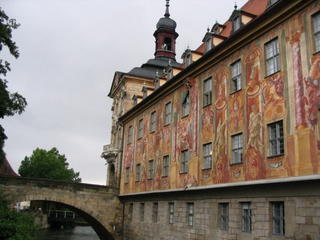 The old town hall with its frescos
The old town hall with its frescos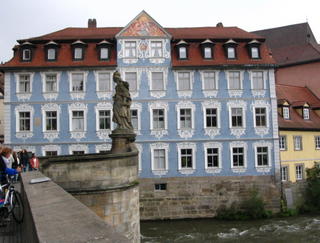 House in the rococo style next to the old town hall
House in the rococo style next to the old town hall Cherubs canvas for the elections
Cherubs canvas for the elections The towers of the Cathedral
The towers of the Cathedral St Michael’s monastery on a hill above the town
St Michael’s monastery on a hill above the town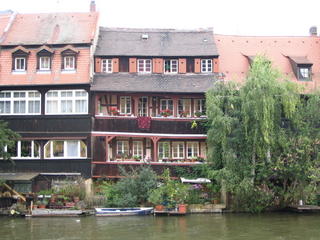 Houses by the river Regnitz
Houses by the river Regnitz The triumphal entrance to the old town hall
The triumphal entrance to the old town hallBecause we were delighted with the name of the restaurant, and because Jill wanted to know what a Kartoffelpuffer was, we went to the Palais Schrottenberg for a “Business Lunch” (Ian wondered whether the plural was Business Lünche). It seems the businessmen of Bamberg gather together to moan about falls in profits and the rationalisation of the workforce as they tuck into Schweinebauch mit Bratkartoffeln und Spiegelei, or Kartoffelpuffer mit Gemüse und frischem Krem. Ian enjoyed his salted belly of pork with roast potatoes and a fried egg, and Jill discovered Kartoffelpuffer are fried potato cakes but was disappointed to discover they have absolutely no puff!
On returning to the campsite in the village of Bug, we discovered the local Gasthaus is called Buger Hof. We took the hint and set of on the final stage of our journey to Weimar around 1.30 p.m.
We actually discovered an empty German motorway on our journey, but then it was still under construction with only two turn-offs. This took us over the former border between East and West Germany. We then entered the Thüringer Wald, wooded uplands with little villages of slate-hung houses along the twisting valley road. We reached Weimar at about 5.30 and remembered our way to Hubert’s home where he was waiting to greet us, although somewhat washed out after giving lectures on two successive days, one in Weimar and the other in Dresden from which he had just returned. We will all be fresher tomorrow after our respective journeys.
Friday 16th September 2005. Weimar
Today has been spent in and around Weimar, a small town steeped in history. It is remarkable how through the centuries it has attracted such a wealth of great names, the painter Cranach in the 16th century, Bach at the start of the 18th, then the golden age when the enlightened regent Anna Amalia attracted Herder, Wieland, Goethe and Schiller. In the 19th century Liszt and Nietzsche were here and in the twentieth the group of figures surrounding the Bauhaus, including Walter Gropius and Henry van der Velde.
Having become familiar with Weimar under the Communist regime of East Germany it astonishes us to see how the fall of the Berlin Wall in 1989 has brought such changes to the lives of the people living here. Small wonder so many of them have found adapting to a united Germany extremely difficult.
We have noticed however, that even today, there is a marked discrepancy in the general standard of living between the two parts of Germany. Here in the east there is generally higher unemployment, wages and pensions are lower, and people have had no opportunity to save for a reasonable standard of living in retirement. Weimar has fared better than most German towns as it has such an immense cultural heritage and has had money provided by the government to restore and improve the many beautiful buildings to be found here, although the finances of the town are now in a parlous state, officials are being laid off and services cut. In the past houses were dilapidated, shared out between several households and hung with huge, garish posters proclaiming socialist unity, workers’ solidarity and similar patriotic sentiments. Today, many buildings have been restored and present beautiful, decorative facades in Art Nouveau style, but, even here, graffiti mar the results. It is so mindless, and for the local people it leads to a sense of frustration and anger.
After breakfast we went down into town, arranging to meet Hubert at lunch time in front of the famous statue of Goethe and Schiller in the Theater Platz. The statue stands in front of the National Theatre where the Weimar Republic was declared in 1919. Unfortunately it later provided the location for an early visit by Hitler.
1418 – Goethe and Schiller in front of the National Theatre
1420 – Commemorative tablet for the Weimar Republic
Apart from wandering around, marvelling at the beautiful buildings and squares, we were anxious to see what had happened to the Anna Amalia Library since 50,000 books were burned, 62,000 damaged and a wealth of paintings and artefacts destroyed in the horrendous fire we witnessed here on 2 September 2004. When we left then the roof was still smouldering. Today it is still out of use and efforts are being made to raise funds to help towards restoration costs of the building and its contents. It is surrounded by scaffolding and the collections are still closed to the public.
The new library with its underground stacks had been due to open just as the fire ruined the original library. We visited this today and registered to use the computer facilities there, although we later discovered that their network was not suitably configured for our purposes. Nevertheless it is a magnificent modern research library with a picture collection, microfilms, music and well supplied with computer terminals.
 The historic Anna Amalia Library swathed in scaffolding
The historic Anna Amalia Library swathed in scaffolding The new Anna Amalia research centre
The new Anna Amalia research centre Burned and damaged books
Burned and damaged books By lunchtime it was pouring with rain. Together with Hubert we climbed the uneven steps to the top of the tower of the Jacobskirche, in process of restoration, for views over the town. Later we went to a tiny Thüringian restaurant for lunch. As with most meals here, it seemed to consist of pork, roast potatoes with cream and fried onions. It was certainly very tasty, ample and filling but we are beginning to hallucinate about salads and fresh vegetables.
 Weimar in the rain from the Jackobskirche
Weimar in the rain from the Jackobskirche Later we returned to the flat to change into more suitable wet weather clothing before walking through the huge, beautiful, wet and overgrown Friedhof (cemetery), where many of the great names of Weimar’s literary and cultural past are buried – Goethe, Schiller and the ducal family of Sachsen-Weimar-Eisenach. It is a dark and romantic place to wander at any time but today, with the rain falling steadily on the leaves of the thickly overhanging trees and the ivy-covered tombs, it was especially so.
Beyond the cemetery we turned into the rest home for the elderly to pay a social call on Hubert’s mother, who at 93 has finally accepted that she needs nursing care. She has known Ian for at least thirty five years and had been greatly looking forward to his visit. Despite the rain falling steadily outside, we spent a pleasant afternoon in her room overlooking a rose garden that would have been delightful in the sunshine.
Later the rain eased and we left to make a soggy walk through Weimar’s beautiful park – laid out in the English style, beside the river Ilm, with statues to literary figures, such as Pushkin and Shakespeare. There is also the house of Franz Liszt and that of Goethe – a present to him by the young Duke Carl August of Weimar. Returning we passed the burnt-out façade of the Anna Amalia library, where we had watched firemen taking shifts to douse the flames on our last visit and made our way up past the Green Palace to the castle where the 15th century religious paintings of the Weimar painter Lucas Cranach are housed. It doesn’t seem to matter where you stand in this beautiful little city, in every direction are stunning palaces, churches, courtyards, parks, fountains and statues. Yet everything is on a relatively modest scale and few towns of a similar size can boast such a galaxy of great names.
 Goethe’s Garden House in the park
Goethe’s Garden House in the park Römisches Haus above the Ilm in the park
Römisches Haus above the Ilm in the park Saturday 17th September 2005, Weimar
Hubert’s friend Antje came from Apolda to the flat this morning to take us for a tour into the edges of the Harz mountains, about 50 Km north of Weimar. We drove across wide plains with extensive open fields that are the legacy of years of collective farming. The rolling nature of the countryside afforded spectacular landscapes with the occasional tiled church tower in the distance and several small wind farms. Eventually the route led into wooded valleys and ended in Stolberg, a wonderful small Harz town, its streets lined with beautifully restored half-timbered houses. The castle above the town is in a state of some neglect but the wide terrace gave us the opportunity to have coffee with naughty cream cakes and to enjoy a view of the village nestling in the valley.
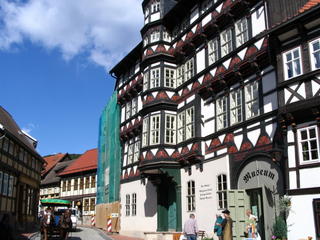 Main street in Stolberg
Main street in Stolberg  View from the castle terrace
View from the castle terrace Cakes on the terrace
Cakes on the terrace Later we drove to the Kyffhäuser monument, the second largest - and almost certainly the ugliest - national monument in Germany. Built in the 1890s in a heavy Germanic style, it purportedly commemorates the Emperor Friedrich Barbarossa, who is supposed to lie sleeping in a cave nearby and will rise to save Germany in its hour of need. (His alarm clock was presumably not working during the time of the Third Reich!) Really the monstrous Denkmal was built as an excuse to glorify Kaiser Bill and the recently united German nation. A colossal bronze equestrian statue of the Emperor stands in front of the tower, which can be climbed to obtain extensive views across the surrounding fertile valleys. During the socialist post-war years there were plans to demolish this monument to German imperialism but instead the interior was fitted out with socialist-realist bronze bas-reliefs, including the text of the East German national anthem, and these remain today as part of the monument’s history. It seems incomprehensible that such a monstrosity could ever have been constructed, but at least nowadays it provides a focal point to a pretty woodland walk and amusement that it could ever have been taken seriously.
 Statue of Barbarossa at the Kyffhaüser monument
Statue of Barbarossa at the Kyffhaüser monument General view of the monument
General view of the monument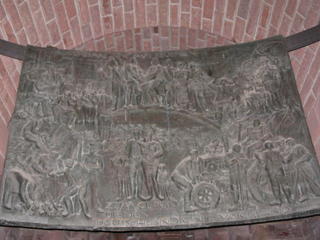 The text of the East German National Anthem
The text of the East German National Anthem View of the surrounding countryside from the top of the monument
View of the surrounding countryside from the top of the monumentOn the way home we stopped for a pleasant supper in a village restaurant, arriving home around 8.30pm. Poor Anje still had a further 20 km to drive to her home in Apolda but we had all spent a very pleasant and happy day.
Sunday 18th September 2005, Weimar
Today was the German national election and first thing this morning we accompanied Hubert to the polling station at the local school. It seems far less complicated than the elections in France and generally very similar to the procedure in Britain. Given the years of predicable elections in East Germany under the former regime, when the only question was whether the Communists would win with 99.6% of the vote or scrape in with a mere 99.4% we were rather surprised at the low turn-out in this area and the indecisive nature of the electorate. As we write the results are expected.
 Hubert casts his vote
Hubert casts his voteAnje arrived at 11am. She gave us a small book of German love poems by Heinrich Heine as a reminder of a lovely weekend and of our first meeting. We then drove through beautiful sunny countryside and pretty Thuringian villages of half-timbered houses and slate roofed churches with their onion-shaped bell towers, to the hills above the university town of Jena, home to Hubert’s daughter Suzie, her husband Jens and Hubert’s two year old grandson, Lucas. Before meeting them though, we went for a walk along the ridgeway of one of the hills overlooking the town. This took us through meadows and along beside hedgerows of autumn berries, rosehips and elderberry bushes to a scenic, hilltop restaurant with a tall tower, Der Fuchsturm, the remains of a mediaeval castle. We lunched on the terrace – sausages with mustard and a flagon of beer - what a surprise! So much of the food here comes sausage-shaped! In the sunshine it was quite hot but there was a definite hint of autumn in the air. The views were superb with the trees in the valley displaying just a hint of yellow.
Since arriving in Germany we have climbed up and down so many staircases, hillsides, cliffs, belfries and monuments that we have discovered muscles in our legs we never knew existed. Today we hobbled our way up to the very top of the spiral staircase in the tower for truly impressive views along and across the steep ridges that stretch out, and end abruptly - like so many fingers, from the Thuringian limestone with small villages nestling in the valleys between them.
 The town of Jena from the Fuchsturm
The town of Jena from the FuchsturmLater we returned down into the town of Jena, to the market square, crowded with people celebrating the local Volksfest. This is really an excuse for everyone to get together and sit at long wooden benches in the sunshine with large glasses of cloudy, sweet new wine – a local speciality, or even larger glasses of local beer, together with garlic bread, sausages, meatballs, Thuringian potato dumplings and Kartoffelpuffer – served with apple sauce, whipped cream and sugar!! Meanwhile a brass band of red-coated musicians played rousing drinking songs – Roll out the barrel, John Brown’s body, and most curious of all, the Helstone Furry Dance! Back in the bad old days of a divided Germany, the music would probably have been stirring Russian marching songs!
 Enjoying a glass of new wine in Jena market square
Enjoying a glass of new wine in Jena market square Locals at the Volksfest
Locals at the VolksfestAfter a couple of glasses of the local brew we had difficulty remembering where we had left the car. Eventually we located it and made our way to Susi’s garden house where we had been invited for “afternoon tea”.
It is very common in Germany that people live together in the town in flats, but have a separate garden on the outskirts. These are not just allotments as we have in England. They usually have a little summer house, fruit trees, a paddling pool and a swing for the children, maybe a small vegetable plot and flowers. They are usually all together, covering several acres of land with pleasant cycle ways passing between them and lovely views of the surrounding countryside. Susi and Jens’ summerhouse has running water, electricity, a small living room, a kitchen and even a toilet. All is very simple and basic however and intended only for summer use.
 Susi’s garden house
Susi’s garden houseWe soon had the barbecue actively cooking pork cutlets and Bockwurst to go with the huge bowl of Kartoffelsalat and bottles of beer waiting on the shady terrace table. So much for our anticipated simple afternoon tea! We were made very welcome. It was lovely to see Susi again and to see how little Lucas has developed since we first met him a year ago. Strange to think that we have known Susi since she was younger than her son is today!
Soon the sun lost its heat and we started to shiver. Time to say goodbye and return to Weimar. Antje and Hubert have work tomorrow and they start very early in Germany. So after a glass of wine to round off the day, we went our different ways. It has been a really lovely weekend.
Monday 19th September 2005, Weimar
Hubert had to work so we were free to look round Weimar on a sunny day. After revisiting some of our favourite sites in the town, we set out along a woodland road to Tiefurt, a village about 2 Km outside Weimar which contains a little country estate which the regent Anna Amalia established for her younger son Constantine during the late 18th century. The little country seat with its original floor coverings and furniture, which we had seen on a previous occasion, was now wrapped in plastic for restoration, but we were able to wander though the English style park beside the little River Ilm with its collection of monuments, pavilions and tea houses. Among them was Anna Amalia’s monument to Constantine, killed in battle during the 1790s. We visited the little village church, the interior delightfully painted in a country style with rough attempts to imitate marble on the wooden pillars that supported the gallery. A lady outside the church begged us to take the windfall apples that were placed in a box by the door.
 Tiefurt church
Tiefurt church Organ in the church
Organ in the church View in Tiefurt park
View in Tiefurt parkBack in the village, after coffee and cakes in the sun, we returned to Weimar along a cycle path by the River Ilm. The path started rather ignominiously by the Weimar water treatment works, located downstream from the town. It eventually brought us through woodland back to the castle. We revistited the nearby Anna Amalia Library and took a lunchtime snack in the library cafeteria. If we were resident here for a longer time, we would certainly frequent this excellent and civilised library regularly. After visiting the beautiful little gardens behind the Kirms Krakow House and the Herder House we looked in at the Bauhaus Museum on the theatre Square. The Bauhaus was in Weimar from 1919 to 1926 (from memory, as we have no guidebooks with us) when it moved on to Dessau under the direction of Walter Gropius, and in that period became instrumental in introducing modern design into all aspects of the decorative arts. Only about 600 of the 9,000 artefacts can be displayed at the moment but there are hopes to expand the museum. Of particular interest was the gallery showing how the first director Henry Van Der Velde changed his style from art nouveau influence to modernism over the twenty years before the establishment of the Bauhaus school in Weimar. There were also many examples of the typographic work of designers such as Moholy-Nagy with his asymmetrical style and innovative use of modern typefaces. The furniture, so groundbreaking in its time, in some cases looked like the dated cast-offs that could be found in second-hand shops. In some ways it is a compliment to the innovative work of the designers in the 1920s that such functional design can be taken so much for granted. In that period Weimar must have been an exciting place to work, with artists and designers such as Kandinsky, Klee and Harry Kessler. We returned via the historic cemetery with its vault containing the remains of the ducal family and also Goethe and Schiller. There we admired the lovely little Russian Orthodox church, established by Anna Paulovna when she married into the ducal family in the late 19th century. Finally we returned home along the Cranach-strasse with its impressive art nouveau houses, now in many cases beautifully restored.
 Goethe’s town house
Goethe’s town house Schiller’s house
Schiller’s house Fountain in the Schillerstrasse
Fountain in the Schillerstrasse Herder and the Herder Kirche
Herder and the Herder Kirche Thuringian State Archive in the former castle stables
Thuringian State Archive in the former castle stables The only Trabant remaining in the former DDR?
The only Trabant remaining in the former DDR? All that survives of the mediaeval castle
All that survives of the mediaeval castle Kirms Krakow Haus
Kirms Krakow Haus Russian Orthodox church
Russian Orthodox church  Art Nouveau house in the Cranachstrasse
Art Nouveau house in the Cranachstrasse 